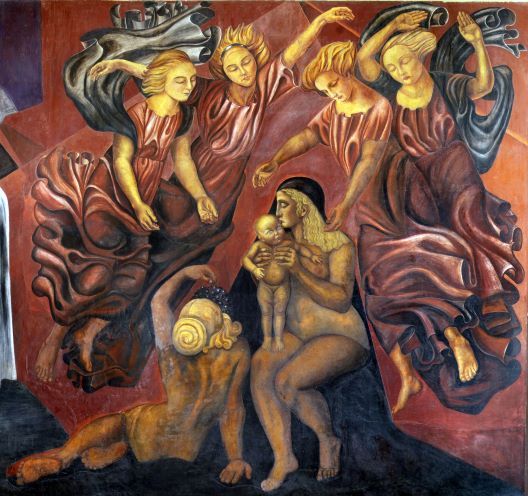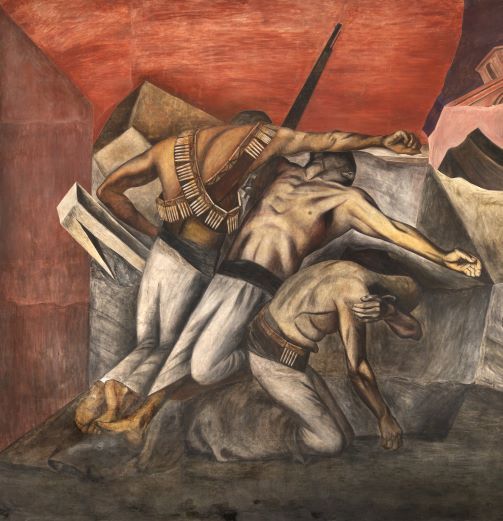José Clemente Orozco's murals at San Ildefonso
Orozco ended up painting over thirty murals, which are scattered across several floors of the San Ildefonso building located in the Historic Center of Mexico City.

When the Jalisco painter José Clemente Orozco joined the Union of Technical Workers, Painters and Sculptors, his comrades - including David Alfaro Siqueiros and Diego Rivera - sought to give the artist space within the walls of San Ildefonso, where several of them had begun to paint murals in the early 1920s.
Initially José Vasconcelos -Secretary of Public Education and one of the great promoters of muralism in Mexico- denied the invitation. However, Vicente Lombardo Toledano, director of the National Preparatory School, offered Orozco a contract "to decorate the main patio, as well as with the painter David Alfaro Siqueiros to decorate the stairs of the small patio", as stated in the Report of the National Preparatory School of 1923.
"Throughout that year, Orozco painted a fresco here that is nothing like what is currently there, except for the one at the end -Maternity- which belongs to that time. It was a landscape with Masonic allegories, esoteric, in the middle of Egyptian pyramids. Then, on the upper floor, he paints some caricatures against political figures of the time belonging to the post-revolutionary regime. This harsh criticism, seasoned with images of fierce anti-Catholicism, led to the termination of his contract at the Preparatory School when there was a political crisis in which José Vasconcelos left," said Renato González Mello, a researcher at the Institute of Aesthetic Research (IIE), in an interview.
In the following two years, Orozco dedicated himself to other projects, although he eventually returned to the walls of San Ildefonso: "In 1926 the rector Alfonso Pruneda García returned the walls to him and when he returned he destroyed what he had painted, except Maternity and the head of Christ, who originally appeared destroying his cross. Before that he paints the second floor and there he captures these friezes with a great story of peasant violence, a very painful one, in which, however, the violence is not explicit. The violence is explicit here in this fresco -La Trinchera-, the panels, according to published sources, are the last ones he painted before leaving for the United States at the end of 1927".
Orozco ended up painting almost thirty murals, which are distributed throughout the different floors of the building located in the Historic Center of Mexico City.

Family violence
"What these frescoes do is build a new consensus for the post-revolutionary elites. Of course, this is an educational institution, but it is not a literacy institution. This is the National Preparatory School and it was one of the elite institutions of pre- and post-revolutionary Mexico. What was painted here was part of the student's conscience and helped to take sides between things that were not too clear at the end of the revolution, to configure the party of the moderns, of those who agree with a process of national modernization," Gonzalez Mello stressed and added:
"Those consensuses were very ambivalent and contradictory, in the case of these murals, which are the second version painted by José Clemente Orozco himself having destroyed the first one which was an immense esoteric allegory, their characteristic is that they put on the wall scenes of peasant violence in Mexico."
Although the end of the Mexican Revolution is placed in 1917 -after the promulgation of the Constitution-, the country continued to experience various violent events throughout its territory, which were the result of the struggle between the various factions that survived the armed conflict. Those who suffered the most directly from this violence were the poorest social classes and peasant communities.
According to the IIE researcher: "This violence was very familiar to the citizens of post-revolutionary Mexico, as it is now for us, and it circulated in images that went through different channels -cards, postcards, and very moderately press images-. José Clemente Orozco realizes that it is an image that should be part of the national conscience in a critical way."
"The characteristic of these murals is that they are part of an artistic project of the State, but very early on they also become an instrument of criticism and that is how they are interpreted when they are painted, they are finished at the end of 1927. The image of peasant Mexico does not reach the walls through José Clemente Orozco, it is Diego Rivera -in the Secretariat of Public Education- who is the first to put that issue on the walls. What Orozco does is, precisely, to say 'yes, peasant life, but violence is part of peasant life and this violence does not end because the revolution is over, we continue to see photographs, we continue to see corpses, we continue to see war'. There is a very critical vision of the Mexican reality", he considered.
To this, he added: "We must not forget that when these frescoes were painted, between 1926 and 1927, there was a war going on in Mexico: La Cristiada. Of course, Orozco was a Jacobin and anti-Catholic, he does not have the slightest sympathy for the Cristeros, but he does have sympathy for the civilian victims of the war. What he does is elaborate the story of the violence."

Reception
The students and faculty of the then National Preparatory School received Orozco's work inside the building in a negative way, some of them showed their dissatisfaction by attacking the murals.
"Almost all the people who wrote in the newspapers and read them had been in an institution like this or here. They showed their rejection of the fact that the Preparatory was covered with paintings of a modernist aspect, because academic painting was not like that, as much as Orozco's academic education is notorious in the murals, the academic painting was not like this mural that shows violence directly without gilding the pill, without mediating it, without imposing notions of decorum based on harmony and symmetry", argued Renato Gonzalez Mello.
He added: "The public, both inside and outside this school, was accustomed to expect the painting that had become widespread in Mexico in the 19th century, very much inspired by neoclassicism and the Nazarenes. It happens that the mural painting project implies a cultural rupture, in a building emblematic of the construction of Mexico's enlightened elites, that is, the National Preparatory School of Gabino Barreda and Justo Sierra. There is, of course, in this controversy also a group of intellectuals who identify with this rupture and this is important because the post-revolutionary governments are not very interested in generating and building a political party with a doctrine".
"The mural painting and the novel of the Mexican Revolution give a pole of identification to constitute itself as a political tendency. Beyond the political game, what there is a social identification of who the revolutionaries are because there is no longer war, there are uprisings and things like that, but it is difficult to distinguish between the different factions. By generating a cultural object that provokes consensus -even if it is polemic- a current of intellectuals who are committed to modernization is born. If there is one thing these murals do not do, it is to propose unconditional support in any dimension. Orozco's provocation goes in all directions and that is its value. It is a critique of everything and against everyone. I think the joke of these murals is to show the importance of saying 'no' in a moment of consensus," said the specialist.
One of the most important points, the researcher identified, is that "it has not happened again that the critic of a political movement is one of the spokesmen of that political consensus. Orozco was an artist of the post-revolutionary State who was never satisfied with being a simple ideologue, a propagandist of the post-revolutionary State. He was a critic of that State and, to that extent, he was one of its intellectuals, it is the negotiation he established to maintain his independence and finally his freedom".

Key images of José Clemente Orozco's murals at San Ildefonso
Among the pieces that make up José Clemente Orozco's mural work in San Ildefonso, González Mello distinguished three that put into context and plenitude the artist's ideas behind this project:
El acecho: "This mural provokes a small crisis inside this school for two reasons. The first is that it portrays Luis Napoleón Morones, leader of the Confederación Regional Obrera Mexicana, an ally of Plutarco Elías Calles who was about to become president of Mexico in 1924. When this work was made, it paints him as a labor leader who has betrayed the workers and appears behind the worker who is there with a red and black flag, there is also a masked character who is about to stab him. Morones in turn is disguised with a crown of thorns, posing as a kind of messianic figure, which he is not. Another thing is that this is a caricature on the wall of an institution that students tend to describe in monumental terms -if not sacred- and it is a desacralization of the building, it is not considered in the 1920s that caricature is an artistic genre and neither that an artistic project of the State has to include caricatures".
El sepulturero: "He is a character who has fallen dangerously asleep at the edge of the grave. To his left and at the beginning of this cycle of murals, there is a group of women, one of whom is pregnant. It is the cycle of life and death. It is a symbolic art, it is not only realistic as has been said, which it is. It is symbolic in a very radical sense because it assumes that there are universal themes: life and death, birth and mourning. This whole hallway on the second floor is built on this supposed cyclical history. It is something that allows for a reinterpretation of what happens on the first floor as part of a narrative. The murals on the first floor, although they show episodes, don't have a narrative thread like this one, and here a little bit of what it says is 'watch out, we're talking about a narrative here'."
La trinchera: "The reds in the background of La trinchera are a considerable technical achievement, it is what distinguishes the work of Orozco and Rivera. There are few works of art in the country as important as this one, it has been reproduced a thousand times and not so many times explained or has been causing for reflection, because the content of Orozco's work, in this case, is a critique of violence and our distance from the peasant. This criticism is still valid and in the media, and political circles, there are still tendencies that would like to omit the images of violence in the countryside and say 'we are not going to show this, this is tremendous, this supports negative perceptions'. With regret, negative perceptions are Mexico's artistic heritage, they are an artistic monument of the nation and that is the content of the official culture of that time. It is a very critical content, the criticism is still in force and so is the need for it".




